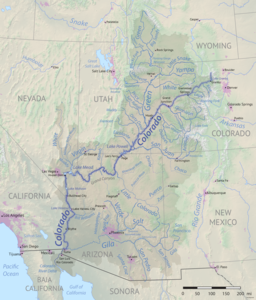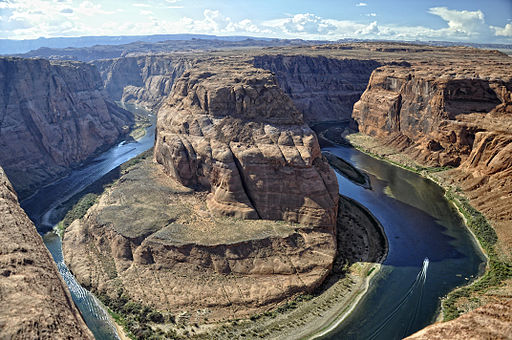
The central theme of denial runs throughout this work. People don’t want to know the details of how they receive water, or how vulnerable Lake Meade may be. Real estate developers in particular do not want an informed community discussion of this topic. Meanwhile, pragmatic water managers are working to build a water intake drain at the very bottom of Lake Meade. While the book focuses on the American southwest, its central issue is that of climate change, which is why I am reviewing it in a course on global studies. The American southwest is a case study for the future, with applicability from Portugal to Iraq.
The U.S. southwest faces sustained warming and drying, even as more people move into the sunbelt in coming decades. The environment that these people enter will change drastically within their lifetimes. In Chapter 2 “Oracle: Global Change Type Drought,” deBuys examines the impact that climate change will have upon entire ecosystems. On page 46, deBuys has a map of Western forests that are being decimated by the spruce beetle, the mountain pine beetle, and the Piñon Ips beetle. The damage extends as far north as the Yukon. My own family lives in British Columbia, where entire swathes of the north have turned red with the needles of dying trees. De Buys describes what may lay in store for the north:
“Until recent years the frigid climate of the Canadian Rockies had kept the beetles on the milder Pacific side of the Continental Divide, but warming temperatures, assisted by the occasional windstorm, have now allowed them to top the passes of the Peace River country and penetrate northern Alberta. Should the insects adapt to the otherwise beetleless jack pines of Canada’s boreal forests, their prospects for continued spread become almost limitless- they might chew their way across the continent to the Atlantic and then turn south for New England, generating transformative ecological effects on an immense scale” (p. 45).
This change is part of a global ecological transformation. Trees are being heat stressed across the globe and key forests are dying or changing (deBuys, p. 154). Of course, no environment lasts forever, which is a theme that deBuys returns to again and again (p. 61, chapter 4, p. 154) in describing the environmental history of the region. To survive, the southwest will have to adapt, to restrict growth, and to make far-sighted choices. The same holds true for many of the globe’s arid regions: North Africa, parts of the Mediterranean, the Middle East and Central Asia.
Some topics that deBuys covers are also all to relevant not only to other parts of the American West, but also all forested regions. Chapter 9, “Mogollon Plateau: Fires Past and Present” is ostensibly about the behavior of fire in the region. This is a topic with broad relevance, given the 2016 wildfire in Fort McMurray, Canada; the June 2017 wildfires in Portugal’s Pedrógão Grande, which killed 66 people; and the 2017 California wildfires. I found this to be one of the strongest chapters of the work, and every word had relevance in other tragedies over the last two years.
This magisterial book should be read by anyone interested in either the American southwest or climate change. DeBuys has a gift for making complex issues comprehensible, from the history of forests to the laws governing water allocation. The story he describes is relevant to many other regions now, from Australia to Spain. Strongly recommended.
DeBuys, W. (2011). A great aridness: climate change and the future of the American southwest. Oxford ; New York: Oxford University Press.

